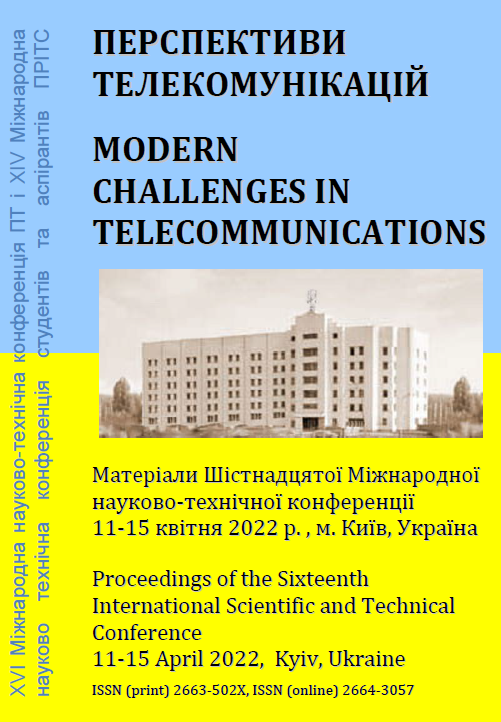SILICON-MICROMACHINED THZ SYSTEMS - ENABLING THE LARGE-SCALE EXPLOITATION OF MILLIMETER AND SUBMILLIMETER-WAVE FREQUENCIES?
Ключові слова:
waveguide, silicon, filters, resonatorАнотація
Current THz systems are predominantly manufactured by CNC milling. Despite the high level of precision which CNC milling achieved in recent years, this fabrication method lacks volume manufacturability and is inferior in performance to silicon micromachining, which achieves feature sizes and fabrication reproducibility down to micrometers, surface roughness down to nanometers (for extremely low loss), and high-aspect ratio geometries which are impossible to fabricate in any other fabrication technology. Micromachined micromechanical devices, for instance mobile-phone microphones and inertial sensors, are already for many years manufactured to billions of devices per year at very low cost. This webinar gives an overview of state of the art, the capabilities and limitations of silicon micromachining for millimeter and submillimeter-wave frequencies, and gives several examples of recent achievements of very high performance silicon-micromachined waveguide based THz devices and systems, including: a low-loss waveguide technology with 0.02 dB/mm at 330 GHz, with integrated components such as low-loss couplers, power splitters, matched loads; micromachined high-Q filter examples based on cavity resonators with measured Q-factors of 1600 at 150 GHz and 900 at 700 GHz, enabling the first 1% fractional bandwidth filters at submillimeter-wave frequencies; a silicon-micromachined platform for a point-to-point telecommunication link including a 130-148 GHz antenna diplexer with 1.5 dB insertion loss and 60 dB isolation, and waveguide-integrated SiGe MMICs; very complex, multi-level waveguide devices including a orthomode transducer from 220-330 GHz with less than 0.6 dB insertion loss and cross-polarization of 35-70 dB in this waveguide band; a corporate-fed antenna array with 256 elements at 320 to 400 GHz, with only 0.8 dB insertion loss, achieving 34 dBi gain; a 1024 antenna array at 320-400 GHz with 38 dBi gain and 1.5 dB insertion loss; a frequency-steering micromachined radar frontend at 220-300 GHz, achieving a 55 degree field of view with a 3.5 to 10 degree HPBW, using an integrated 2.5D quasi-optical reflector and a leaky-wave antenna array, all of the size and thickness of a thumb nail; MEMS-waveguide switches operating at 140-220 GHz with 0.6 dB insertion loss and 50 dB isolation over the whole band, and even a 500-750 GHz switch with 2.5 dB insertion loss and 18 dB isolation; and a 2.5-dB insertion loss 360 degree phase shifter for the 220-330 GHz band with less than 4 degree phase error for all states over the whole bandwidth. Major applications presented are radar (in particular next-generation car radars), telecommunication and space-borne radiometers.##submission.downloads##
Опубліковано
2022-05-22
Як цитувати
Oberhammer, J. . (2022). SILICON-MICROMACHINED THZ SYSTEMS - ENABLING THE LARGE-SCALE EXPLOITATION OF MILLIMETER AND SUBMILLIMETER-WAVE FREQUENCIES?. Збірник матеріалів Міжнародної науково-технічної конференції «ПЕРСПЕКТИВИ ТЕЛЕКОМУНІКАЦІЙ», 14–16. вилучено із https://conferenc-journal.its.kpi.ua/article/view/255152
Номер
Розділ
ПЛЕНАРНІ ЗАСІДАННЯ
Ліцензія

Ця робота ліцензується відповідно до Creative Commons Attribution 4.0 International License.
Authors who submit to this conference agree to the following terms:a) Authors retain copyright over their work, while allowing the conference to place this unpublished work under a Creative Commons Attribution License, which allows others to freely access, use, and share the work, with an acknowledgement of the work's authorship and its initial presentation at this conference.
b) Authors are able to waive the terms of the CC license and enter into separate, additional contractual arrangements for the non-exclusive distribution and subsequent publication of this work (e.g., publish a revised version in a journal, post it to an institutional repository or publish it in a book), with an acknowledgement of its initial presentation at this conference.
c) In addition, authors are encouraged to post and share their work online (e.g., in institutional repositories or on their website) at any point before and after the conference.

